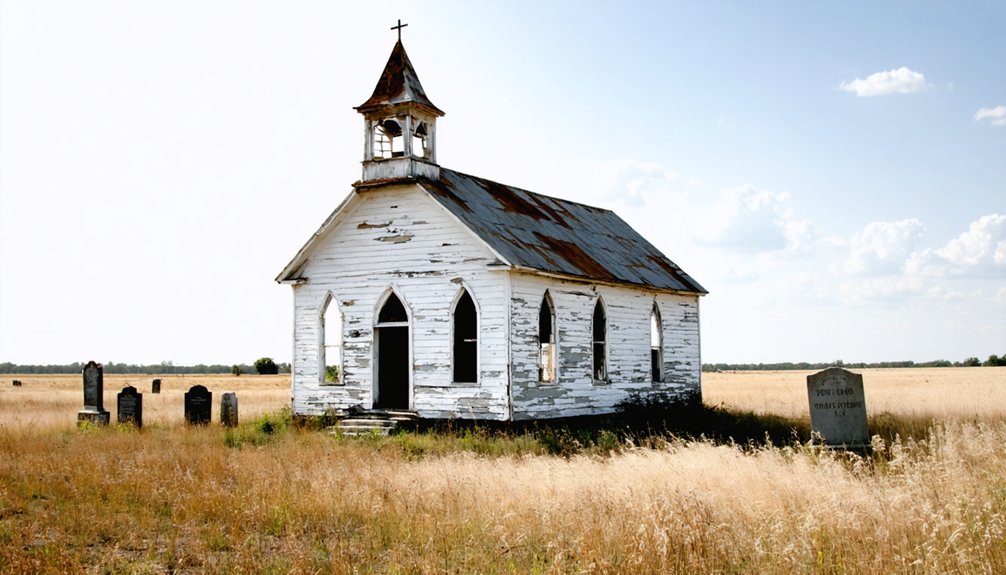You’ll find Peyton Colony in the rugged hills between Blanco and Caldwell counties, Texas, where freedman Peyton Roberts established a thriving settlement in 1865. The community grew to encompass 5,000 acres of farmland, featuring the Mt. Horeb Baptist Church (1874), a post office, and the area’s first Black school. While most original structures haven’t survived, the historic cemetery with 176 graves and church remains stand as evidence to this remarkable freedmen’s colony’s enduring legacy.
Key Takeaways
- Peyton Colony began as a freedmen’s settlement in Caldwell County, Texas, but has largely disappeared from its original 5,000-acre expanse.
- Only the Mt. Horeb Baptist Church and cemetery remain as physical landmarks of the once-thriving Black farming community.
- The colony’s decline occurred gradually as residents moved away, though some descendants still own portions of the original land.
- The cemetery contains 176 graves of original settlers and their families, serving as a historical record of the community.
- Agricultural buildings, homes, and the post office that once formed this self-sufficient community have vanished over time.
The Vision of Peyton Roberts
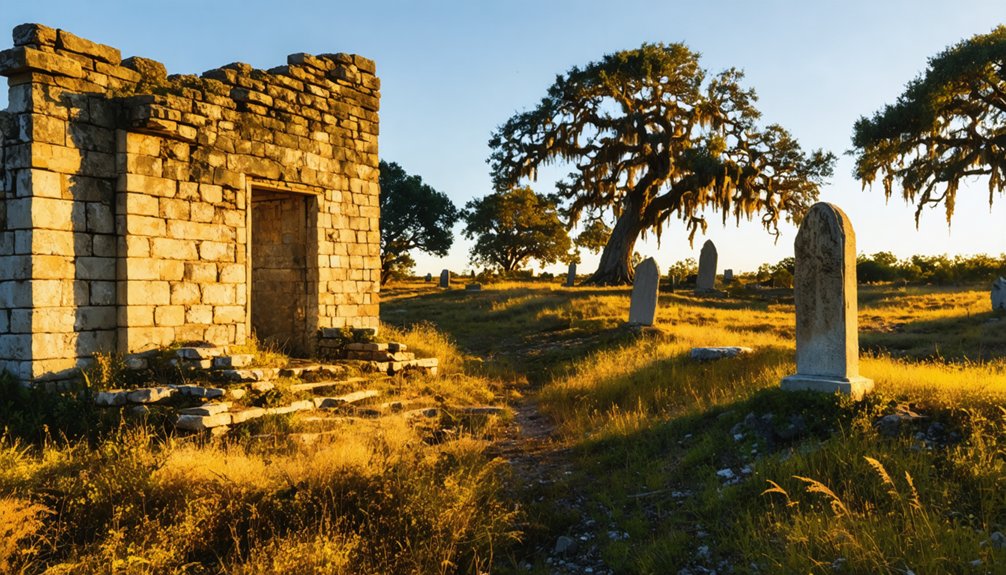
After gaining his freedom in 1865, Peyton Roberts established Peyton Colony in Caldwell County, Texas as a settlement for formerly enslaved people seeking autonomy and self-sufficiency.
His leadership focused on securing land through preemption acts, ensuring that freed families could build their futures on property they owned outright.
Securing land rights empowered freed families to establish permanent roots and build generational wealth through property ownership.
You’ll find that Roberts’ vision extended beyond mere land acquisition – he built essential infrastructure including a lime kiln for construction and supported the founding of Mt. Horeb Baptist Church in 1874.
His emphasis on agricultural development and community resilience created a framework where former slaves could shift to paid labor and achieve economic independence.
The colony grew along Boardhouse Creek, where early settlers constructed cabins and developed their homesteads.
Through his strategic planning, the colony developed strong institutions that fostered both spiritual growth and civic engagement. To avoid confusion with other locations, historical records needed to specify this settlement as Peyton Colony, Texas to distinguish it from similarly named places.
From Slavery to Settlement
Following his emancipation during the Civil War, Peyton Roberts and other freed slaves transformed their status by establishing Peyton Colony in Texas around 1865, where they’d acquire over 5,000 acres through preemption claims.
You’ll find that these former slaves, who’d worked for William Roberts in exchange for post-war supplies, strategically built their settlement in Bastrop and Caldwell counties.
The colony’s residents secured their independence through 160-acre land grants, creating a self-sustaining farming community that would serve as a testament to their resilience and determination to build free lives.
The community established the Mt. Horeb Baptist Church in 1874, which became the central gathering place for religious and educational activities.
Like many other freedmen settlements, the community experienced a significant decline in the 1920s, leading to a diminished population and reduced agricultural activity.
Freedom Through Land Ownership
Land ownership represented the ultimate symbol of freedom for former slaves in post-Civil War Texas, and Peyton Roberts embodied this pursuit when he established Peyton Colony in 1865.
Through the government’s preemption program, Roberts and other freed individuals acquired their own parcels, transforming the dream of independence into reality.
The colony’s foundation rested on farming, which provided sustenance and economic stability for the newly freed families. This community resilience proved lasting – many descendants of the original settlers still own their ancestors’ land today. The historic 350-acre site stands as a testament to their determination and success. The log cabin church served as a vital gathering place where the community would share Sunday meals after services.
The preemption program, which allowed settlers to purchase government land, continued until 1876, followed by land grants until 1880. For these former slaves, each acre represented not just soil to cultivate, but the tangible reward of their long-fought battle for autonomy.
Building Community After Emancipation
While the quest for land ownership marked a significant step toward freedom, the broader challenge of building sustainable communities shaped the lives of emancipated African Americans throughout Texas.
You’ll find that these settlers established essential anchor institutions – churches, schools, and cemeteries – that became the heartbeat of their newfound freedom. These focal points fostered community resilience through regular gatherings, from funerals to festivals. The 557 Freedom Colonies were established across Texas between 1865 and 1930, creating vital safe spaces for Black communities.
By 1870, when Texas finally recognized formerly enslaved marriages and legitimized children, the African American population had grown to 30% of the state’s residents.
Through oral histories and commemorative events, you can trace how these communities preserved their cultural heritage, maintaining strong social networks even as homesteads remained physically dispersed across the landscape. Many of these communities developed despite facing persistent racial violence and terror from white residents who opposed their independence.
Building a Free Community
After settling in Texas’s Hill Country through preemption laws in 1865, you’d find Peyton Colony‘s residents working together to establish essential community structures, including homes and agricultural plots.
You’ll note that the Mt. Horeb Baptist Church, built in 1874, quickly became the heart of the colony, serving as both a spiritual center and gathering place for the freed families.
The church, along with the first Black school in Blanco County, created a support network that strengthened the colony’s social bonds and helped guarantee its survival through the challenging post-Civil War years. The colony’s founder Peyton Roberts established this freedmen’s settlement in a particularly scenic region of eastern Blanco County.
Post-War Land Acquisition
Through the process of preemption following the Civil War, freedmen could establish legal claims to public lands before receiving formal title, creating opportunities for formerly enslaved people to build independent communities.
In this environment, Peyton Roberts acquired his initial tract and established what would become Peyton Colony. The land policies of the time, which continued until 1880, enabled other freed families to follow his example and secure their own parcels.
While ownership disputes stemming from earlier empresario grants often complicated the acquisition process, the settlers persevered. They navigated the shifting legal landscape of post-war Texas to secure farmland and space for community infrastructure.
This determination led to permanent settlement, marked by individual claims that descendants would maintain well into the 20th century.
Community Support Networks
Despite the challenges of post-Civil War reconstruction, Peyton Colony’s freed residents built remarkably effective support networks that sustained their independence and growth.
You’ll find evidence of their community resilience in the widespread practice of cooperative farming, shared labor arrangements, and pooled resources. Neighbors worked together to construct homes, the Mt. Horeb Baptist Church, and the first black school in Blanco County.
They’d share farming equipment and livestock while maintaining informal childcare and elder support systems.
The church, established in 1874, became the heart of mutual support, coordinating assistance during hardships and hosting community gatherings.
Through work-for-supplies arrangements with former owners, families acquired tools and provisions, strategically building their self-sufficiency while maintaining strong social bonds that would sustain generations.
Church as Gathering Place
The founding of Mount Horeb Baptist Church in 1874 marked a pivotal moment in Peyton Colony’s development as a free Black settlement. Built on land donated by freedman Jim Upshear, the log church became the heart of community fellowship, serving as both a house of worship and the area’s first school.
You’ll find that gathering rituals began even before the permanent structure was complete, with early services held in tents. Under Reverend Jack Burch’s leadership, the church unified scattered Black settlers and attracted newcomers seeking refuge in the Hill Country. Many families had journeyed from William Roberts Plantation to establish this new community.
The building’s dual purpose maximized limited resources, hosting religious services, community meetings, and educational activities under one roof. This sacred space fostered collective decision-making and intergenerational learning, becoming a cornerstone of liberty and self-determination.
Daily Life in the Colony
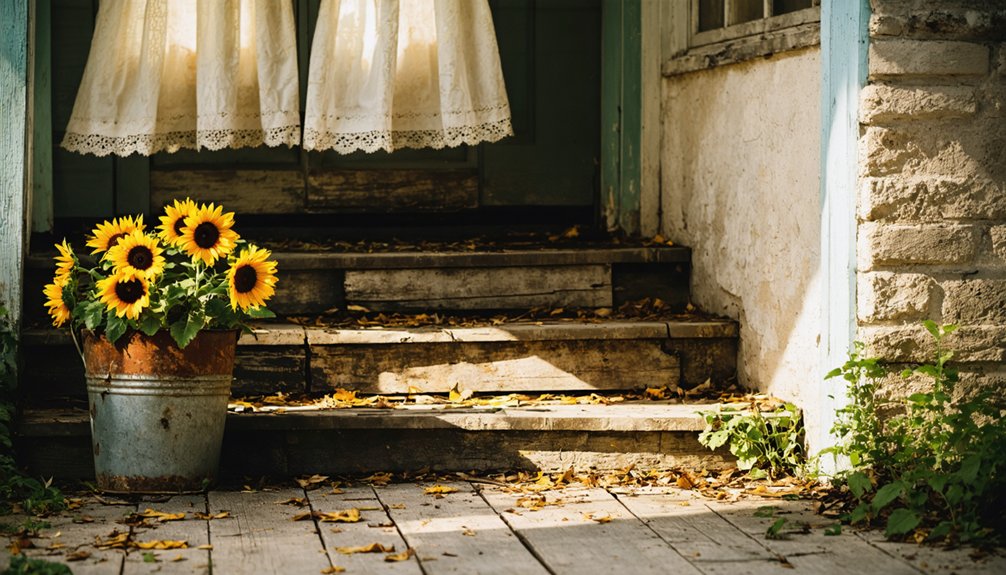
Daily life in Peyton Colony revolved around three key institutions: Mt. Horeb Baptist Church, the local schoolhouse, and family homes built by freed settlers.
You’d find daily routines centered on farming activities, with residents working their land and tending to greenhouses. Water came from wells and nearby creeks, supporting both household needs and agriculture.
Community gatherings took place regularly at Mt. Horeb Baptist Church, where Rev. Jack Burch led services on land donated by Jim Upshear. Families worked together using local materials, including mortar from Peyton Roberts’ lime kiln, to construct sturdy homes that would stand for generations.
These houses, passed down through families, represented the colony’s commitment to building lasting roots. Children divided their time between helping with chores, attending school, and participating in church activities.
Economic Activities and Survival
While agriculture formed the backbone of Peyton Colony’s economy, residents developed multiple income streams to guarantee their survival.
You’d find farmers cultivating their land while also raising cattle on the fertile grazing fields, demonstrating remarkable economic resilience through agricultural diversity. The colony’s lime kiln production proved crucial, providing mortar for local construction and potentially generating additional income through trade with neighboring communities.
You’ll notice how the community embraced self-sufficiency while maintaining significant connections through their post office, which operated from a modest board house.
Skilled laborers like blacksmiths and carpenters complemented the farming operations, while small business owners likely ran important services.
This economic framework supported the colony until broader regional changes and isolation eventually led to its decline.
Religious and Educational Foundations
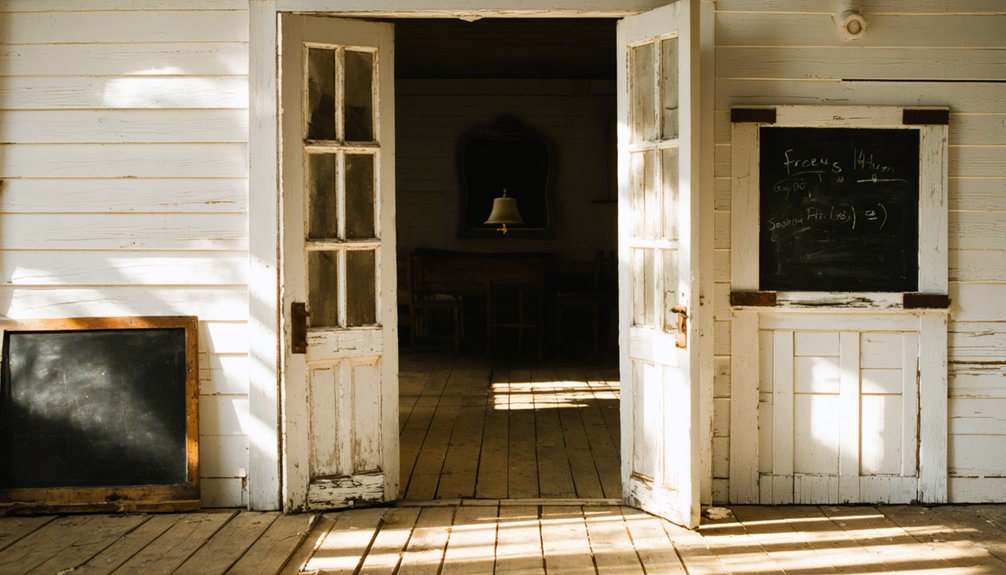
Since its establishment in 1874, Mt. Horeb Baptist Church has stood as the cornerstone of Peyton Colony’s spiritual life.
You’ll find this historic church, built on land donated by Jim Upshear, remains a symbol of the community’s religious foundations under Rev. Jack Burch’s early leadership.
The colony’s church history intertwines with its educational significance through the establishment of Blanco County’s first black school.
You can trace how these institutions shaped the community’s development, with the church serving as a gathering place while the school educated generations of children until integration in the 1960s.
Though the colony’s population has declined over the years, both structures still stand as physical reminders of the freed slaves who built this remarkable community and their determination to create lasting foundations for future generations.
Notable Landmarks and Structures
As you explore Peyton Colony today, the most striking physical reminders of its history are the extensive rock walls that stretch along the old road between Blanco and Wimberley. These walls, built by freedmen farmers, mark property lines and showcase the community’s resourcefulness in using local materials.
Mount Horeb Baptist Church stands as a symbol of Peyton Colony’s cultural heritage, while the old school building recalls the first black educational institution in Blanco County.
The cemetery, with its 176 graves including Peyton Roberts himself, provides essential genealogical links to the original settlers. Throughout the site, you’ll find scattered ruins of homes and other structures that hint at the colony’s former liveliness, offering glimpses into the daily lives of these pioneering freedmen who built their own independent community.
Legacy of the Freedmen’s Colony
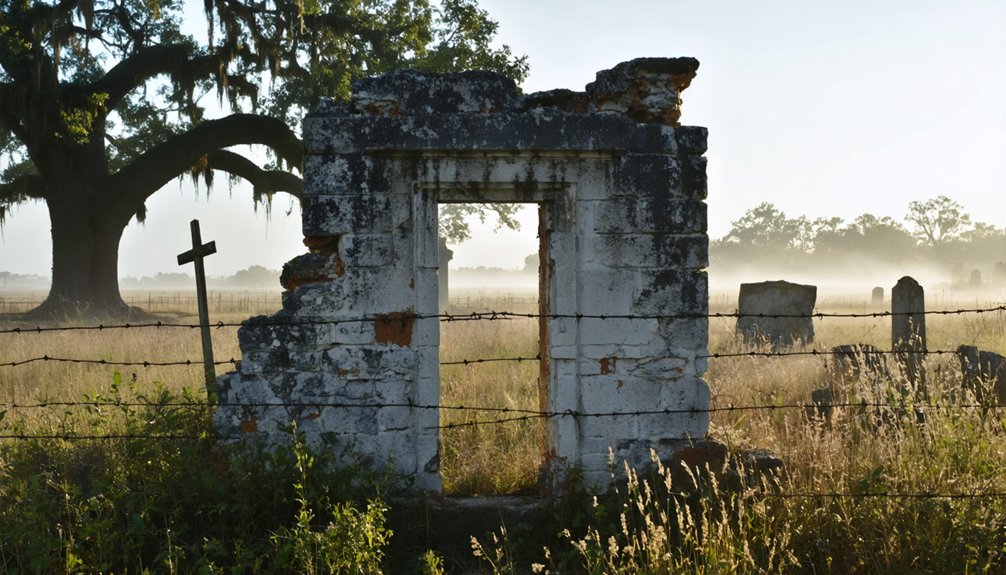
Although Peyton Colony’s physical presence has diminished over time, its enduring legacy speaks to the remarkable achievements of formerly enslaved people in post-Civil War Texas.
You’ll find this cultural heritage preserved through the descendants who still own much of the original land, and in the 176 grave markers that tell the story of generations who built a self-sufficient Black community in the Texas Hill Country.
The colony’s social resilience shines through its many firsts: Blanco County’s first Black school, a thriving Baptist church that anchored community life, and innovative enterprises like the lime kiln operation.
Even as the population declined in the 20th century, Peyton Colony’s example of Black self-determination, land ownership, and community building continues to inspire through historical markers and documented records.
Preserving the Past Today
Today’s efforts to preserve Peyton Colony’s rich history unfold through multiple channels.
You’ll find KLRU’s PBS documentary spotlighting both historical significance and paranormal activity, while the Save Texas History Program supports preservation initiatives.
Community storytelling through oral traditions keeps the colony’s legacy alive, though access remains limited due to private property restrictions.
Local voices preserve Peyton Colony’s story despite limited access, passing heritage through generations of shared memories and narratives.
- Mt. Horeb Baptist Church stands as a central landmark for historical preservation
- The restored lime kiln from 1960 represents successful conservation efforts
- Digital documentation and paranormal investigations create new interest in the site
While few residents remain in the area, descendants of original settlers maintain ownership of much of the land.
Educational programs and collaboration with local historical societies guarantee that Peyton Colony’s remarkable story endures for future generations.
Frequently Asked Questions
What Happened to Peyton Roberts After Founding the Colony?
You’ll find that after founding the colony, Peyton Roberts stayed in the area, farming and leading his community despite the colony’s economic challenges, leaving a lasting legacy until his death.
Were There Any Conflicts With Neighboring White Settlements?
Like ships passing in darkness, you’ll find no documented racial tensions or settlement disputes between Peyton Colony and white neighbors. Historical records suggest economic cooperation through farming and lime production instead.
How Did Residents Communicate With Other Freedmen Communities in Texas?
You’ll find residents relied heavily on letter writing through the post office (1898-1909, 1918-1930), oral traditions during church gatherings, and informal networks developed through wagon train routes across Texas.
What Traditional Customs or Celebrations Were Practiced in Peyton Colony?
You’d find traditional celebrations centered on church gatherings, Juneteenth commemorations, harvest festivals, and seasonal religious events at Mt. Horeb Baptist Church, where community gatherings fostered cultural preservation and spiritual connection.
Did Any Residents Serve in Law Enforcement or Local Government?
Despite 100+ years of history, you won’t find records of residents serving in law enforcement or local government. They focused on farming and church leadership through Mt. Horeb Baptist Church instead of official positions.
References
- https://en.wikipedia.org/wiki/Peyton
- https://artistforlandscapes.wordpress.com/category/ghost-towns/
- https://www.ghosttowns.com/states/tx/peytoncolony.html
- https://reneguerrero.com/texas-urban-legend-series-peyton-colony-austin-tx/
- https://blackpast.org/african-american-history/peyton-colony-boardhouse-texas/
- https://www.tshaonline.org/handbook/entries/peyton-tx-blanco-county
- https://www.youtube.com/watch?v=Mk7FvvfYOpw
- https://www.texasescapes.com/TexasHillCountryTowns/Peyton-Colony-Texas.htm
- https://old.blackpast.org/african-american-history/peyton-colony-boardhouse-texas/
- https://www.findagrave.com/memorial/24584248/peyton-roberts
